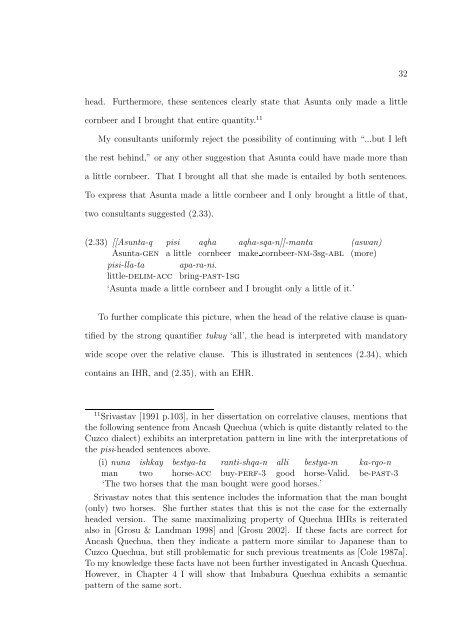the syntax and semantics of relativization and quantification
the syntax and semantics of relativization and quantification
the syntax and semantics of relativization and quantification
You also want an ePaper? Increase the reach of your titles
YUMPU automatically turns print PDFs into web optimized ePapers that Google loves.
32<br />
head. Fur<strong>the</strong>rmore, <strong>the</strong>se sentences clearly state that Asunta only made a little<br />
cornbeer <strong>and</strong> I brought that entire quantity. 11<br />
My consultants uniformly reject <strong>the</strong> possibility <strong>of</strong> continuing with “...but I left<br />
<strong>the</strong> rest behind,” or any o<strong>the</strong>r suggestion that Asunta could have made more than<br />
a little cornbeer. That I brought all that she made is entailed by both sentences.<br />
To express that Asunta made a little cornbeer <strong>and</strong> I only brought a little <strong>of</strong> that,<br />
two consultants suggested (2.33).<br />
(2.33) [[Asunta-q pisi aqha aqha-sqa-n]]-manta (aswan)<br />
Asunta-gen a little cornbeer make cornbeer-nm-3sg-abl (more)<br />
pisi-lla-ta apa-ra-ni.<br />
little-delim-acc bring-past-1sg<br />
‘Asunta made a little cornbeer <strong>and</strong> I brought only a little <strong>of</strong> it.’<br />
To fur<strong>the</strong>r complicate this picture, when <strong>the</strong> head <strong>of</strong> <strong>the</strong> relative clause is quantified<br />
by <strong>the</strong> strong quantifier tukuy ‘all’, <strong>the</strong> head is interpreted with m<strong>and</strong>atory<br />
wide scope over <strong>the</strong> relative clause. This is illustrated in sentences (2.34), which<br />
contains an IHR, <strong>and</strong> (2.35), with an EHR.<br />
11 Srivastav [1991 p.103], in her dissertation on correlative clauses, mentions that<br />
<strong>the</strong> following sentence from Ancash Quechua (which is quite distantly related to <strong>the</strong><br />
Cuzco dialect) exhibits an interpretation pattern in line with <strong>the</strong> interpretations <strong>of</strong><br />
<strong>the</strong> pisi-headed sentences above.<br />
(i) nuna ishkay bestya-ta ranti-shqa-n alli bestya-m ka-rqo-n<br />
man two horse-acc buy-perf-3 good horse-Valid. be-past-3<br />
‘The two horses that <strong>the</strong> man bought were good horses.’<br />
Srivastav notes that this sentence includes <strong>the</strong> information that <strong>the</strong> man bought<br />
(only) two horses. She fur<strong>the</strong>r states that this is not <strong>the</strong> case for <strong>the</strong> externally<br />
headed version. The same maximalizing property <strong>of</strong> Quechua IHRs is reiterated<br />
also in [Grosu & L<strong>and</strong>man 1998] <strong>and</strong> [Grosu 2002]. If <strong>the</strong>se facts are correct for<br />
Ancash Quechua, <strong>the</strong>n <strong>the</strong>y indicate a pattern more similar to Japanese than to<br />
Cuzco Quechua, but still problematic for such previous treatments as [Cole 1987a].<br />
To my knowledge <strong>the</strong>se facts have not been fur<strong>the</strong>r investigated in Ancash Quechua.<br />
However, in Chapter 4 I will show that Imbabura Quechua exhibits a semantic<br />
pattern <strong>of</strong> <strong>the</strong> same sort.
















